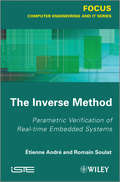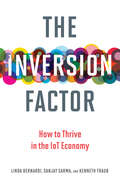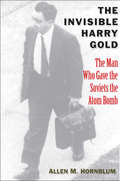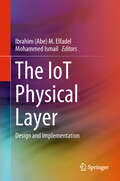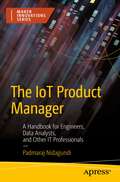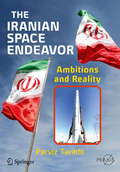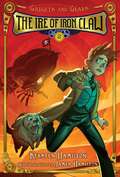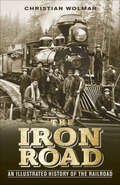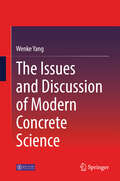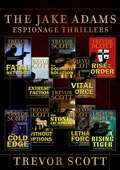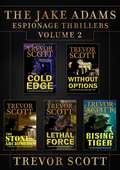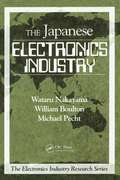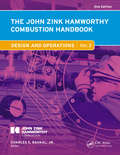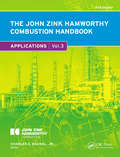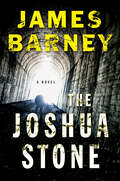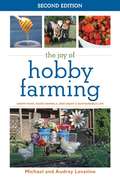- Table View
- List View
The Inventors of LEGO® Toys (Awesome Minds)
by Erin Hagar Paige GarrisonEveryone has played with LEGO® toys, but not many people know who is behind this awesome invention. This fun and engaging book tells the story of how a Danish carpenter and his family turned a desperate situation into the most popular toy in history. <P><P>With full-color illustrations and lively text, and chock-full of interesting facts, Awesome Minds: The Inventors of LEGO® Toys is the perfect read for those with creative spirits and curious minds. <P><P>This book is an independently authored and published biography of the family that created the LEGO® construction toy and is not sponsored or endorsed by or affiliated in any way with the LEGO Group of companies, owner of the LEGO® trademarks. <br>Lexile Level: 970L <br>Guided Reading Level: R4
The Inverse Method: Parametric Verification of Real-time Unbedded Systems (Focus Ser. #4)
by Romain Soulat Etienne AndréThis book introduces state-of-the-art verification techniques for real-time embedded systems, based on the inverse method for parametric timed automata. It reviews popular formalisms for the specification and verification of timed concurrent systems and, in particular, timed automata as well as several extensions such as timed automata equipped with stopwatches, linear hybrid automata and affine hybrid automata. The inverse method is introduced, and its benefits for guaranteeing robustness in real-time systems are shown. Then, it is shown how an iteration of the inverse method can solve the good parameters problem for parametric timed automata by computing a behavioral cartography of the system. Different extensions are proposed particularly for hybrid systems and applications to scheduling problems using timed automata with stopwatches. Various examples, both from the literature and industry, illustrate the techniques throughout the book. Various parametric verifications are performed, in particular of abstractions of a memory circuit sold by the chipset manufacturer ST-Microelectronics, as well as of the prospective flight control system of the next generation of spacecraft designed by ASTRIUM Space Transportation. Contents: 1. Parametric Timed Automata. 2. The Inverse Method for Parametric Timed Automata. 3. The Inverse Method in Practice: Application to Case Studies. 4. Behavioral Cartography of Timed Automata. 5. Parameter Synthesis for Hybrid Automata. 6. Application to the Robustness Analysis of Scheduling Problems. 7. Conclusion and Perspectives. About the Authors Étienne André is Associate Professor in the Laboratoire d’Informatique de Paris Nord, in the University of Paris 13 (Sorbonne Paris Cité) in France. His current research interests focus on the verification of real-time systems. Romain Soulat is currently completing his PhD at the LSV laboratory at ENS-Cachan in France, focusing on the modeling and verification of hybrid temporal systems.
The Inversion Factor: How to Thrive in the IoT Economy (The\mit Press Ser.)
by Linda Bernardi Sanjay E. Sarma Kenneth TraubWhy companies need to move away from a “product first” orientation to pursuing innovation based on customer need.In the past, companies found success with a product-first orientation; they made a thing that did a thing. The Inversion Factor explains why the companies of today and tomorrow will have to abandon the product-first orientation. Rather than asking “How do the products we make meet customer needs?” companies should ask “How can technology help us reimagine and fill a need?” Zipcar, for example, instead of developing another vehicle for moving people from point A to point B, reimagined how people interacted with vehicles. Zipcar inverted the traditional car company mission. The authors explain how the introduction of “smart” objects connected by the Internet of Things signals fundamental changes for business. The IoT, where real and digital coexist, is powering new ways to meet human needs. Companies that know this include giants like Amazon, Airbnb, Uber, Google, Tesla, and Apple, as well as less famous companies like Tile, Visenti, and Augury. The Inversion Factor offers a roadmap for businesses that want to follow in their footsteps.The authors chart the evolution of three IoTs—the Internet of Things (devices connected to the Internet), the Intelligence of Things (devices that host software applications), and the Innovation of Things (devices that become experiences). Finally, they offer a blueprint for businesses making the transition to inversion and interviews with leaders of major companies and game-changing startups.
The Invisible Harry Gold
by Allen M. HornblumIn the history of Soviet espionage in America, few people figure more crucially than Harry Gold. A Russian Jewish immigrant who spied for the Soviets from 1935 until 1950, Gold was an accomplished industrial and military espionage agent. He was assigned to be physicist Klaus Fuchs's "handler" and ultimately conveyed sheaves of stolen information about the Manhattan Project from Los Alamos to Russian agents. He is literally the man who gave the USSR the plans for the atom bomb. The subject of the most intensive public manhunt in the history of the FBI, Gold was arrested in May 1950. His confession revealed scores of contacts, and his testimony in the trial of the Rosenbergs proved pivotal. Yet among his co-workers, fellow prisoners at Lewisburg Penitentiary, and even those in the FBI, Gold earned respect, admiration, and affection. InThe Invisible Harry Gold, journalist and historian Allen Hornblum paints a surprising portrait of this notorious yet unknown figure. Through interviews with many individuals who knew Gold and years of research into primary documents, Hornblum has produced a gripping account of how a fundamentally decent and well-intentioned man helped commit the greatest scientific theft of the twentieth century.
The IoT Physical Layer: Design And Implementation (Analog Circuits And Signal Processing Series)
by Mohammed Ismail Ibrahim Abe ElfadelThis book documents some of the most recent advances on the physical layer of the Internet of Things (IoT), including sensors, circuits, and systems. The application area selected for illustrating these advances is that of autonomous, wearable systems for real-time medical diagnosis. The book is unique in that it adopts a holistic view of such systems and includes not only the sensor and processing subsystems, but also the power, communication, and security subsystems. Particular attention is paid to the integration of these IoT subsystems as well as the prototyping platforms needed for achieving such integration. Other unique features include the discussion of energy-harvesting subsystems to achieve full energy autonomy and the consideration of hardware security as a requirement for the integrity of the IoT physical layer. One unifying thread of the various designs considered in this book is that they have all been fabricated and tested in an advanced, low-power CMOS process, namely GLOBALFOUNDRIES 65nm CMOS LPe.
The IoT Product Manager: A Handbook for Engineers, Data Analysts, and Other IT Professionals
by Padmaraj NidagundiEnhance your product management skills and set yourself apart from other product managers working in the IoT industry. This book shows you how to navigate through the world of small and Edge devices to successfully launch and monitor products connected together to make smart environments.Working in Agile environments, you'll learn to guide UI builds that serve customer needs and function the way top tech companies expect. Then measure the right product metrics and create reporting dashboards for your IoT products. That way you can effectively engage partners, engineers, and stakeholders. And you’ll learn the entire end-to-end development process of IoT products so that you can make sure you make the right moves at the right stages. After mastering the IoT product lifecycle and measuring your success against KPIs, you’ll see how to work with marketing to effectively launch your product in the marketplace. Finally, a self-interview section has been provided so that you can evaluate your skills and responses to common IoT Product Manager questions. Then take what you've learned and go out into the world to develop integrated IoT products that your customers love!What You'll LearnCreate UI/UX experiences that engage and wow your customersWork in Agile environments with best business practicesNegotiate effectively at each step of the product lifecycleWho This Book Is ForAny wanting to build a IoT products. Aspiring Internet of Things product managers, product owners, analysts, business consultants, engineers, and business owners.
The Iranian Space Endeavor
by Parviz TarikhiProvides a detailed look at the events and policies surrounding the Iranian space endeavor. For those who see the trend of progress and movement of the Iranian space endeavor from the outside, it can be difficult to understand what goes on behind the scenes. However, for one who observes these events firsthand, they take on a very different meaning. In this book, the author brings new and different profiles of Iran's space endeavor to light. Iran claims to be the ninth leading country in the world capable of manufacturing satellites and launching them, plans to land an astronaut on the Moon within a decade, and says its own president plans to be the first Iranian astronaut to travel into space. The author explains in this book that not all of these claims are quite as they seem. In addition to technical explanations, the book also includes historical, legal, social and cultural aspects of Iran's space program as well. It is the author's goal to create a tangible feeling of Iran's space endeavor for the readers.
The Ire of Iron Claw
by James Hamilton Kersten HamiltonSomeone is smuggling secrets out of the Kennewicketts' lab and sabotaging their experiments, putting everyone at the Amazing Automated Inn at risk. In pursuit of the villains, the family of scientific geniuses board their dirigible and take to the skies. Together with their robotic staff and the inventor Nikola Tesla, they must face murderous sky pirates, cross the Alps in a giant mechanical spider, and defy the perilous pigeon Iron Claw and the malevolent magician Madini once more. Will boy inventor Wally and his daring dog, Noodles, be able to defeat the evil Mesmers and their minions a second time? History and technology collide in this fast-paced series narrated by a daring dachshund and brimming with mad science.
The Iron Road: An Illustrated History of the Railroad (DK Short Histories)
by Christian WolmarWritten by Christian Wolmar, author of the critically acclaimed The Great Railroad Revolution, The Iron Road is a richly illustrated account of the rise of the rails across the world. From the historic moment in September 1830 when the first train ran between Liverpool and Manchester, to the high speed trains bulleting across Asia and Europe, The Iron Road: An Illustrated History of the Railroad looks at how railroads have changed the world. Photographs, maps, paintings, and illustrations bring events and locations to life, adding a unique visual quality to the stories of great invention, feats of mind-boggling engineering, groundbreaking changes in trade and commerce, and tales of adventurers, visionaries, and rogues. The Iron Road is the third title in DK's successful illustrated histories format, which combines text-rich narratives with beautiful visual design.
The Island of Peril (Department Z #15)
by John CreaseyDepartment Z must stop the Nazis from deploying a deadly chemical weapon during World War II—from the author who sold eighty million books worldwide. On a top-secret island, the Germans are perfecting a paralyzing gas—one that could disable an entire infantry troop, a crew of a ship, or the pilots of aircraft. With the looming threat of this noxious gas, it’s up to Department Z to find this mysterious island where the gas is being manufactured and steal the formula to prevent the Germans from using it as their ultimate weapon. “Mr. Creasey realizes that it is the principal business of thrillers to thrill.” —Church Times “Little appears in the newspapers about the Secret Service, but that little makes anything on the subject probable fiction. Mr. Creasey proves himself worthy of the chance.” —The Times Literary Supplement
The Issues and Discussion of Modern Concrete Science
by Wenke YangThis book is devoted to two primary objectives. The first is to present the errors, inadaptability, and mistakes arising when the current theory on concrete is applied to explaining practical construction of concrete; the second is to put forward viewpoints in modern concrete science. Taking a number of engineering cases as examples, we experimentally studied and theoretically analyzed the errors, inadaptability, and mistakes when the current theory on concrete is applied to explaining practical construction of concrete. Moreover, we investigated the use of mixing ratios, aggregates, cement, high-performance concrete and fibers, as well as the frost resistance, cracking behavior, durability, dry shrinkage and autogenous healing to address and remedy the shortcomings in today's concrete science, put forward new proposals, and make a number of innovative achievements in the field, particularly in modern theory on concrete science. The results and topics which will be of particular interest to engineers and researchers include: corrections to several one-sided, even mistaken views on concrete construction in the field and a new theory that can be adopted to improve the durability of concrete projects, to control and improve the implementation quality of concrete projects, and to guide teaching in universities. Wenke Yang is a distinguished senior engineer at China Airport Construction Group Corporation, General Administration of Civil Aviation of China (CAAC).
The Issues and Discussion of Modern Concrete Science
by Wenke YangThis book is devoted to two primary objectives. The first is to present the errors, inadaptability, and mistakes arising when the current theory on concrete is applied to explaining practical construction of concrete; the second is to put forward viewpoints in modern concrete science.Taking a number of engineering cases as examples, we experimentally studied and theoretically analyzed the errors, inadaptability, and mistakes when the current theory on concrete is applied to explaining practical construction of concrete. Moreover, we investigated the use of mixing ratios, aggregates, cement, high-performance concrete and fibers, as well as the frost resistance, cracking behavior, durability, dry shrinkage and autogenous healing to address and remedy the shortcomings in today’s concrete science, put forward new proposals, and make a number of innovative achievements in the field, particularly in modern theory on concrete science. The results and topics which will be of particular interest to engineers and researchers include: corrections to several one-sided, even mistaken views on concrete construction in the field and a new theory that can be adopted to improve the durability of concrete projects, to control and improve the implementation quality of concrete projects, and to guide teaching in universities. Wenke Yang is a distinguished senior engineer at China Airport Construction Group Corporation, General Administration of Civil Aviation of China (CAAC).
The Italian Antimafia, New Media, and the Culture of Legality
by Robin Pickering-IazziThe past two decades have witnessed increasing opposition to mafia influence and activities in Italy. Community organizations such as Libera, founded in 1995, and Addiopizzo, originating in 2004, exemplify how Italian society has tried to come together to promote antimafia activities. The societal opposition to mafia influence continues to grow and the Internet has become a frontline in the battle between the two groups. The Italian Antimafia, New Media, and the Culture of Legality is the first book to examine the online battles between the mafia and its growing cohort of opponents. While the mafia’s supporters have used Internet technologies to expand its power, profits, and violence, antimafia citizens employ the same technologies to recreate Italian civil society. The contributors to this volume are experts in diverse fields and offer interdisciplinary studies of antimafia activism and legality in online journalism, Twitter, YouTube, digital storytelling, blogs, music, and photography. These examinations enable readers to understand the grassroots Italian cultural revolution, which makes individuals responsible for promoting justice, freedom, and dignity.
The JCT 05 Standard Building Contract
by Issaka Ndekugri Michael RycroftThe Joint Contracts Tribunal's (JCT) Standard Form of Building Contract, one of the most common standard contracts used in the UK to procure building work, is updated regularly to take account of changes in legislation and industry practice and relevant court decisions from litigation. The JCT 05 Standard Building Contract: Law and Administration is a second edition to the authors' earlier award-winning The JCT98 Building Contract: Law and Administration, and clarifies complex issues surrounding obligations and rights under the contract. This makes it an essential reference for construction professionals, employers, contractors, and lawyers new to construction seeking to update and consolidate their knowledge. The book also provides the knowledge and understanding of the contract, which are a fundamental part of the education of most students who go on to become managers and leaders in the construction industry. It thoroughly works through the provisions of the contract in simple language, using case law examples and relevant statute to demonstrate approaches to its interpretation.
The Jake Adams Espionage Thrillers: The First Ten Novels (A Jake Adams International Espionage Thr)
by Trevor ScottThe complete Jake Adams Espionage Thrillers series. Includes all 10 books: Fatal Network, Extreme Faction, The Dolomite Solution, Vital Force, Rise of the Order, The Cold Edge, Without Options, The Stone of Archimedes, Lethal Force, and Rising Tiger.
The Jake Adams Espionage Thrillers: Volume 2 (A Jake Adams International Espionage Thr)
by Trevor ScottA Simon & Schuster eBook. Simon & Schuster has a great book for every reader.
The Jake Adams International Espionage Thrillers: Volume 1 (A Jake Adams International Espionage Thr #1)
by Trevor ScottVolume 1 of the Best Selling Jake Adams International Espionage Thriller series containing books 1-5, Fatal Network, Extreme Faction, The Dolomite Solution, Vital Force, and Rise of the Order.
The Japanese Electronics Industry
by Michael Pecht Wataru Nakayama WIlliam BoultonThe explosive growth of the Japanese electronics industry continues to be driven by a combination of market forces and the unique characteristics of the Japanese social organization and people. As an industrial phenomenon, the Japanese electronics industry receives considerable attention from researchers in various fields. However, most of their studies focus on either historical analyses intent on discovering the secret of the industry's enormous success, or on the issue of America's competitiveness in the face of challenges from Japanese technology. Moreover, none of these studies can be free of the bias that stems from each researcher's own upbringing and environment.The authors of The Japanese Electronics Industry have pooled their diverse experience and talents to create a balanced, objective study of this complex subject. They illuminate the history and characteristics of the industry, show the current state of the industry, and explore the research, development, and education vital to the future of the industry.
The Jet Alphabet Book (Jerry Pallotta's Alphabet Books)
by Jerry PallottaPrepare for takeoff! Jerry Pallotta brings us another high-flying alphabet book with a lot of velocity. THE JET ALPHABET BOOK propels young minds into the wild blue yonder to fly with Goblins and Nighthawks while they lock in solid reading skills. Learn that the Flying Falcon, while able to carry 3000 pounds of fuel, can only fly for an hour and a half. The Dream, a Russian jet, is large enough to carry ten school buses! Zillions of other exciting facts about the jet age zoom across the pages of this book.
The John Zink Hamworthy Combustion Handbook: Volume 1 - Fundamentals (Industrial Combustion)
by Charles E. BaukalDespite the length of time it has been around, its importance, and vast amounts of research, combustion is still far from being completely understood. Environmental, cost, and fuel consumption issues add further complexity, particularly in the process and power generation industries. Dedicated to advancing the art and science of industrial combusti
The John Zink Hamworthy Combustion Handbook: Volume 2 Design and Operations (Industrial Combustion)
by Charles E. Baukal.Despite the length of time it has been around, its importance, and vast amounts of research, combustion is still far from being completely understood. Issues regarding the environment, cost, and fuel consumption add further complexity, particularly in the process and power generation industries. Dedicated to advancing the art and science of industr
The John Zink Hamworthy Combustion Handbook: Volume 3 Applications (Industrial Combustion)
by Charles E. BaukalDespite the length of time it has been around, its importance, and vast amounts of research, combustion is still far from being completely understood. Issues regarding the environment, cost, and fuel consumption add further complexity, particularly in the process and power generation industries. Dedicated to advancing the art and science of industr
The Joshua Stone: A Novel
by James BarneySome secrets belong to the past. Others refuse to stay there . . .In 1959, in an underground laboratory in a remote region of West Virginia, a secret government experiment went terribly awry. Half a dozen scientists mysteriously disappeared, and all subsequent efforts to rescue them failed. In desperation, President Eisenhower ordered the lab sealed shut and all records of its existence destroyed. Now, fifty-four years later, something from the lab has emerged.When mysterious events begin occurring along the New River Valley in West Virginia, government agents Mike Califano and Ana Thorne are sent to investigate. What they discover will shake the foundations of science and religion and put both agents in the crosshairs of a deadly, worldwide conspiracy. A powerful and mysterious force has been unleashed, and it's about to fall into the wrong hands. To prevent a global catastrophe, Califano and Thorne must work together to solve a biblical mystery that has confounded scholars for centuries. And they must do so quickly, before time runs out . . . forever.
The Journey to Dissertation Success: For Construction, Property, and Architecture Students
by Paul Watson Elizabeth Laycock Tim HowarthAre you about to embark on a research project for the first time? Unsure which data collection methods are right for your study? Don't know where to start? By presenting the reader with a series of key research management questions, this book introduces the novice researcher to a range of research designs and data collection methods. Building an understanding of these choices and how they can impact on the dissertation itself will lead to a more robust and rigorous dissertation study. This book is designed to direct your research choices with informative text and key questions, advice from "virtual supervisors" and reflections from students. Lists of suggested further reading also help to support you on your journey to developing an organised and successful dissertation project. Researchers seeking support on their journey to a successful dissertation will find this book a valuable resource.
The Joy of Hobby Farming: Grow Food, Raise Animals, and Enjoy a Sustainable Life (Joy of Series)
by Michael Levatino Audrey LevatinoWhen the farm is a lifestyle, but not quite a way to earn a living, it’s considered hobby farming. Most of us want to live a sustainable and healthy life in which we protect the environment and keep it safe from development and overproduction. But we can take this a step further by learning how to grow our own produce, while still maintaining an alternative, successful career to fund this passion. In this back to basics guide, Michael and Audrey Levatino share how to:Grow your own foodRaise chickens, horses, llamas, bees, and morePractice being (a little) off the gridSell the bounty in your local communityBalance a professional career with a rural lifestyleThe Joy of Hobby Farming is a guide that will excite armchair farmers and inspire any do-it-yourselfer. While this book won’t help you become a farmer by trade, it does provide step-by-step instructions and various tips and tricks to maintain a thriving farm. It will surely teach those who aren’t farmers by day to raise their own livestock, plant their own fruits and vegetables, and live out their countryside dream.

